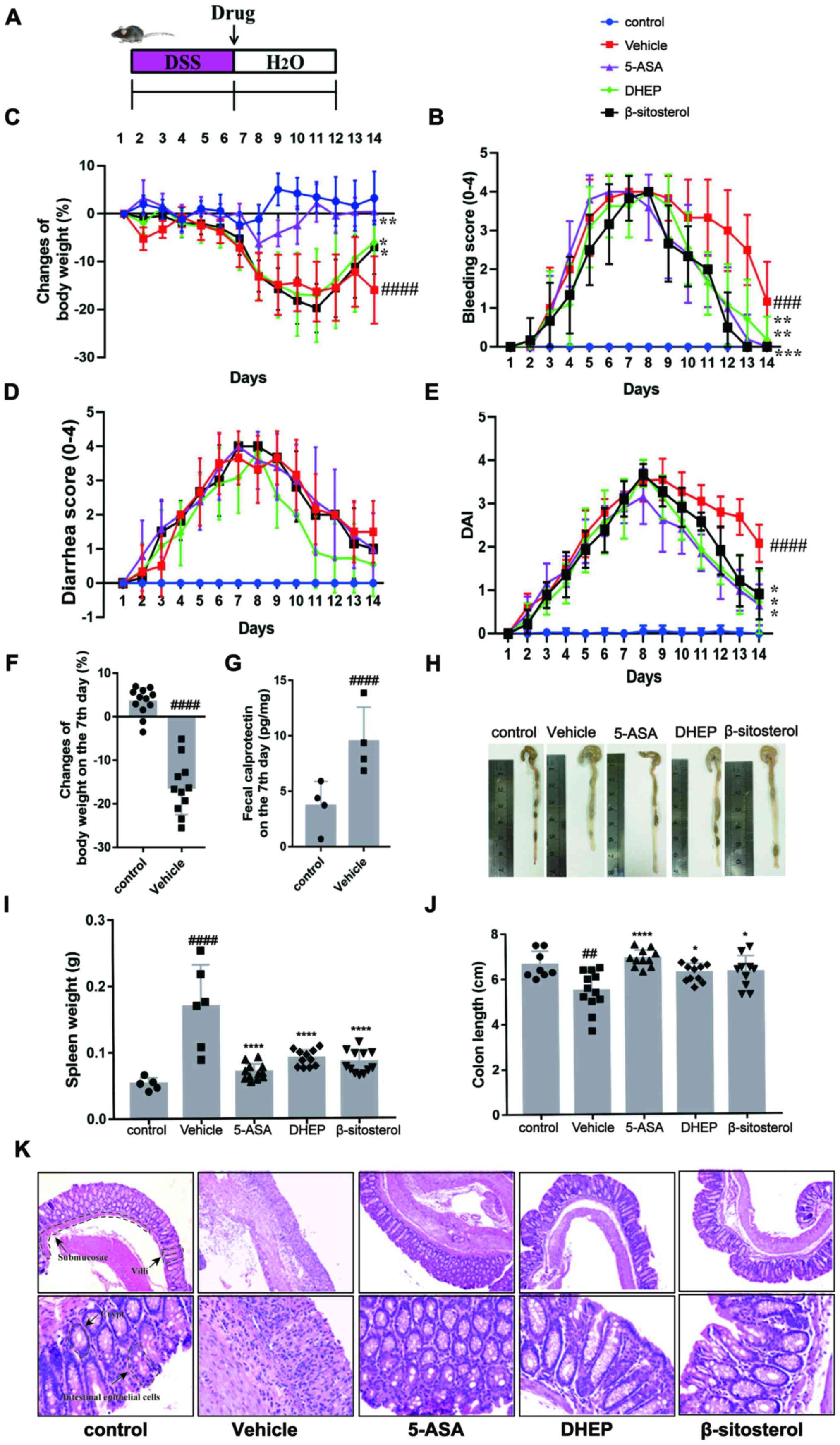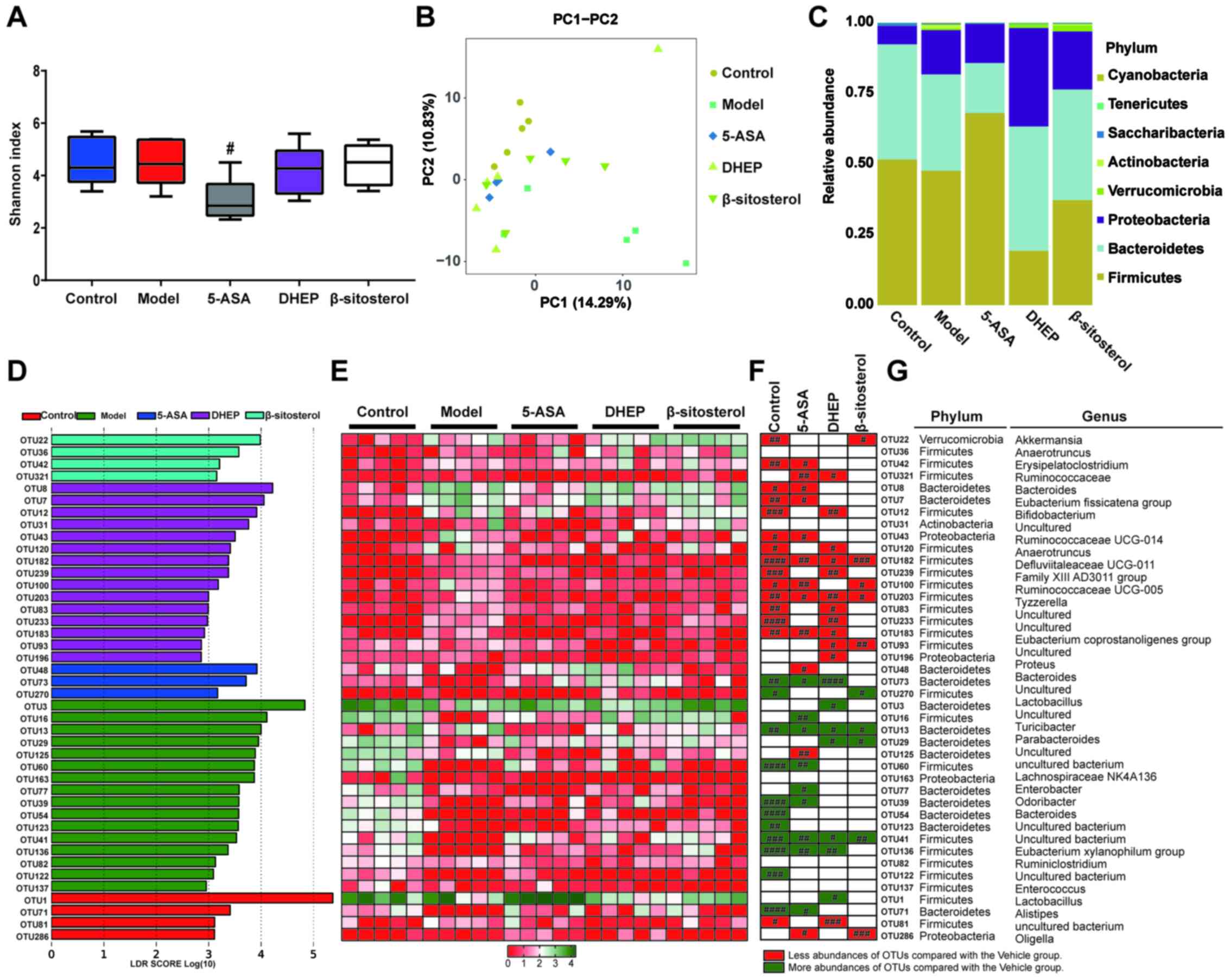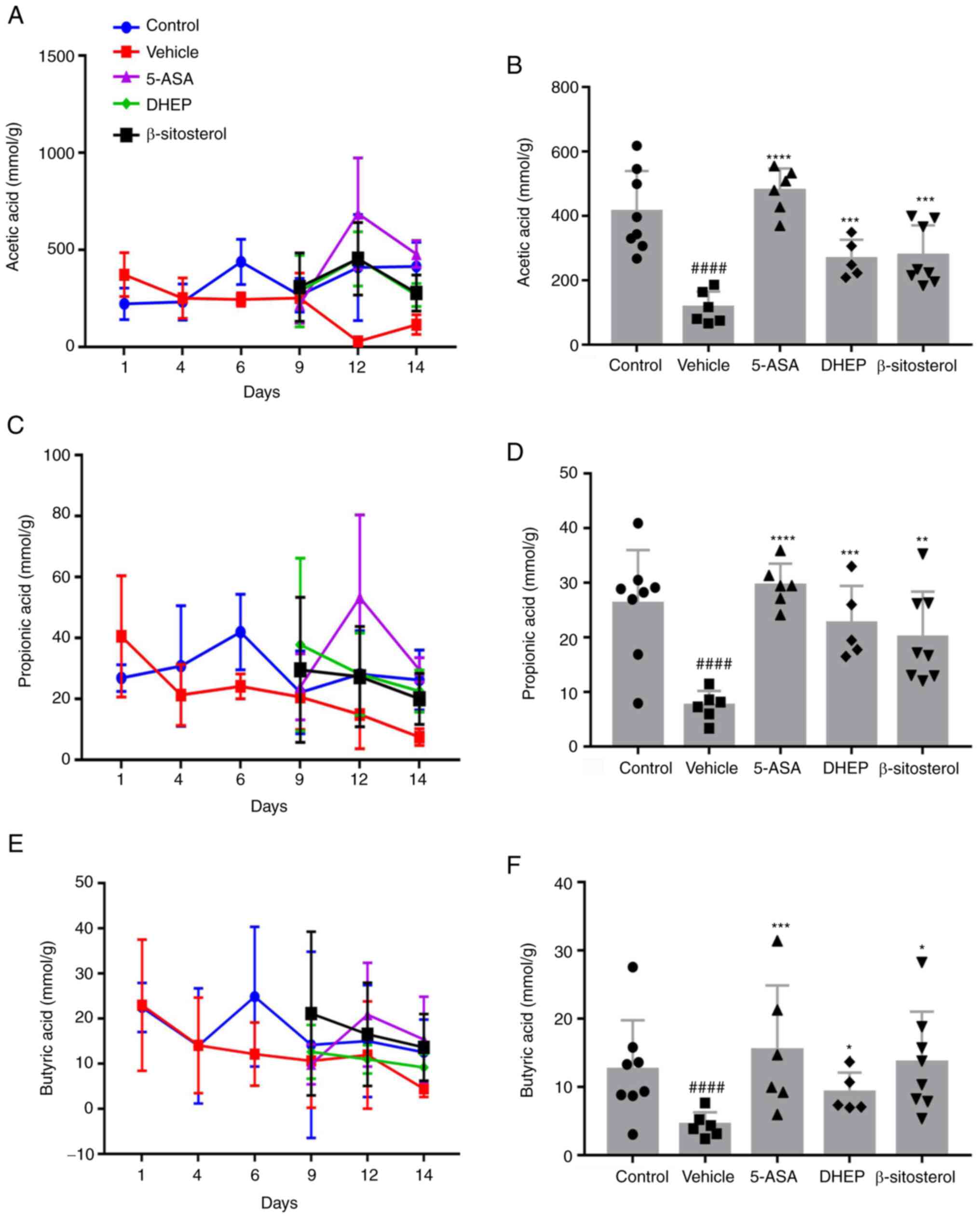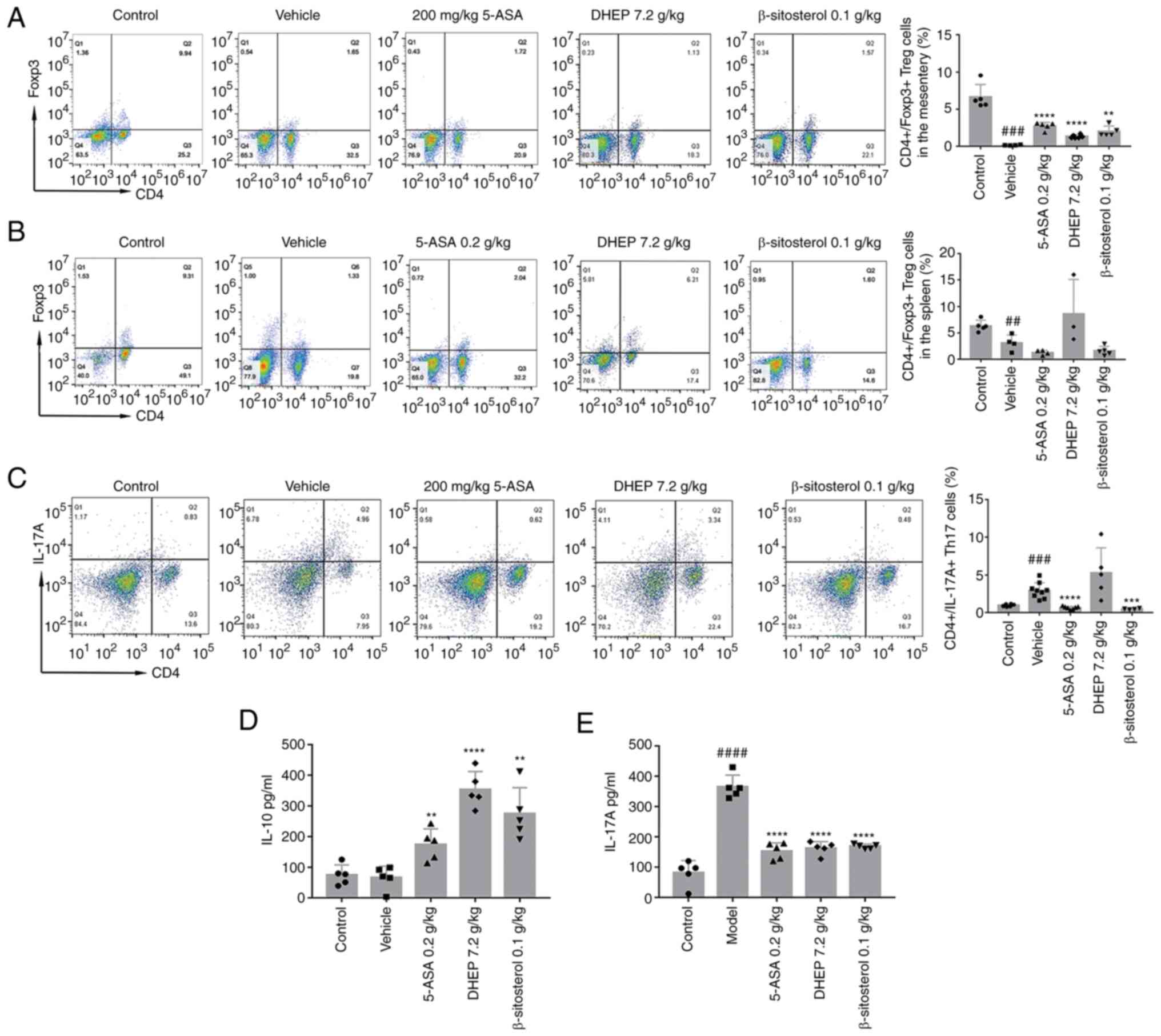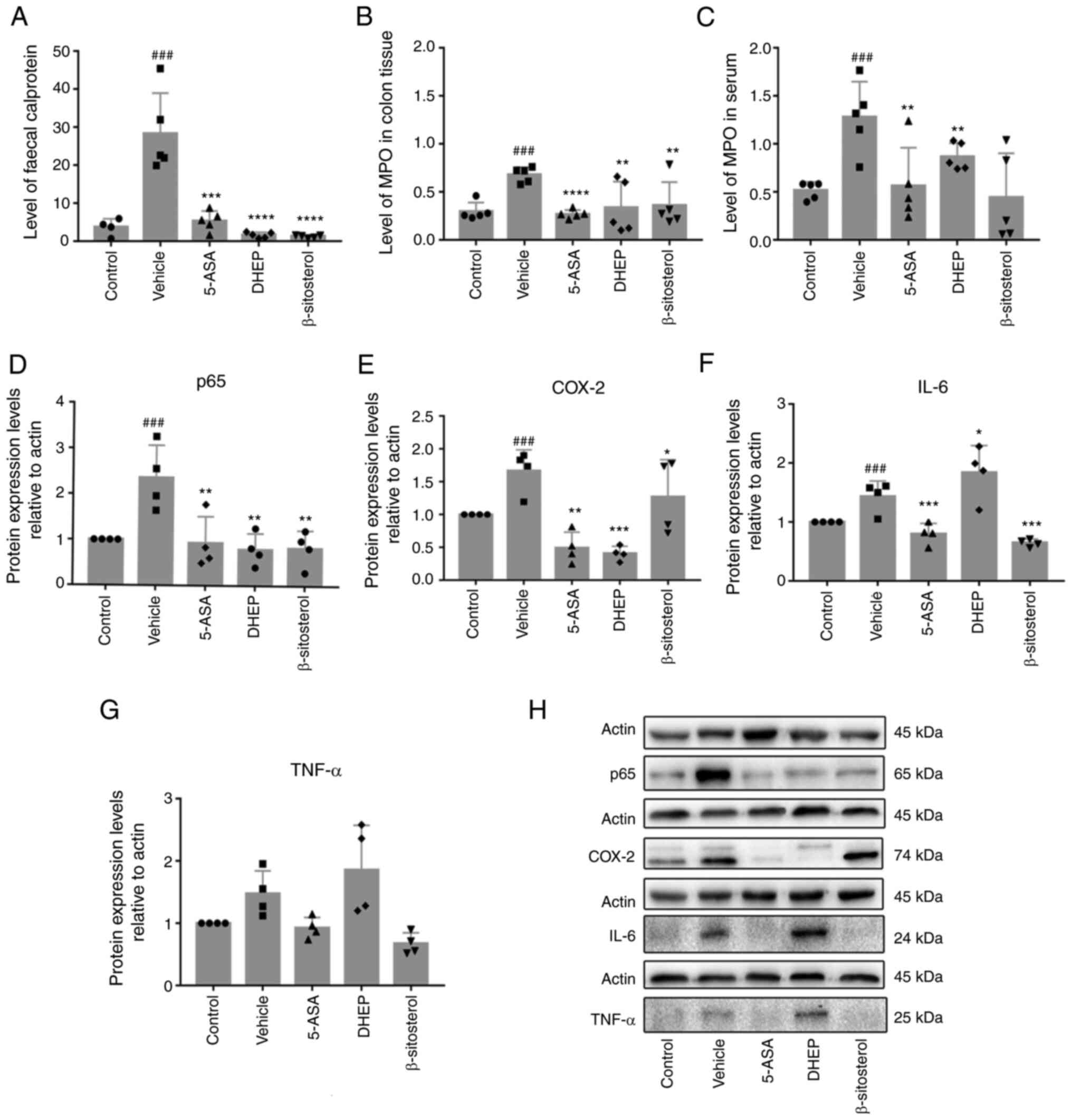|
1
|
Guan Q: A Comprehensive review and update
on the pathogenesis of inflammatory bowel disease. J Immunol Res:
Dec 1, 2019 (Epub ahead of print). doi: 10.1155/2019/7247238.
|
|
2
|
Desreumaux P and Colombel JF:
Modifications and roles of intestinal flora in inflammatory bowel
diseases. Gastroenterol Clin Biol. 25:C89–C93. 2001.
|
|
3
|
Huang Y and Chen Z: Inflammatory bowel
disease related innate immunity and adaptive immunity. Am J Transl
Res. 8:2490–2497. 2016.PubMed/NCBI
|
|
4
|
Coskun M, Vermeire S and Nielsen OH: Novel
targeted therapies for inflammatory bowel disease. Trends Pharmacol
Sci. 38:127–142. 2017.PubMed/NCBI View Article : Google Scholar
|
|
5
|
Rogler G: Where are we heading to in
pharmacological IBD therapy? Pharmacol Res. 100:220–227.
2015.PubMed/NCBI View Article : Google Scholar
|
|
6
|
Zheng K, Shen H, Jia J, Lu Y, Zhu L, Zhang
L and Shen Z: Traditional Chinese medicine combination therapy for
patients with steroid-dependent ulcerative colitis: Study protocol
for a randomized controlled trial. Trials. 18(8)2017.PubMed/NCBI View Article : Google Scholar
|
|
7
|
Sałaga M, Zatorski H, Sobczak M, Chen C
and Fichna J: Chinese herbal medicines in the treatment of IBD and
colorectal cancer: A review. Curr Treat Options Oncol. 15:405–420.
2014.PubMed/NCBI View Article : Google Scholar
|
|
8
|
Shicai H, Kang D and Xu Y: Clinical
efficacy of Kuijie enema liquid by air- ressured herb enema
combined with Zhuling Xianglian decoction in the treatment of
ulcerative colitis and its effect on the level of inflammatory
factors of patients. Hebei J Tradit Chin Med. 41:367–371. 2019.(In
Chinese).
|
|
9
|
Shen T, He YL, Sun GP, Liu WX and Zheng
SZ: Studies on chemical constituents of Sanguisorba longifolia
Bertol. Indian J Chem B. 47:1600–1604. 2008.
|
|
10
|
He X, Wang X, Fang J, Zhao Z, Huang L, Guo
H and Zheng X: Bletilla striata: Medicinal uses, phytochemistry and
pharmacological activities. J Ethnopharmacol. 195:20–38.
2017.PubMed/NCBI View Article : Google Scholar
|
|
11
|
Feng S, Dai Z, Liu A, Wang H, Chen J, Luo
Z and Yang CS: β-Sitosterol and stigmasterol ameliorate dextran
sulfate sodium-induced colitis in mice fed a high fat Western-style
diet. Food Funct. 8:4179–4186. 2017.PubMed/NCBI View Article : Google Scholar
|
|
12
|
Paniagua-Pérez R, Flores-Mondragón G,
Reyes-Legorreta C, Herrera-López B, Cervantes-Hernández I,
Madrigal-Santillán O, Morales-González JA, Álvarez-González I and
Madrigal-Bujaidar E: Evaluation of the anti-inflammatory capacity
of beta-sitosterol in rodent assays. Afr J Tradit Complement Altern
Med. 14:123–130. 2016.PubMed/NCBI View Article : Google Scholar
|
|
13
|
Liz R, Zanatta L, dos Reis GO, Horst H,
Pizzolatti MG, Silva FR and Fröde TS: Acute effect of β-sitosterol
on calcium uptake mediates anti-inflammatory effect in murine
activated neutrophils. J Pharm Pharmacol. 65:115–122.
2013.PubMed/NCBI View Article : Google Scholar
|
|
14
|
Kim KA, Lee IA, Gu W, Hyam SR and Kim DH:
β-Sitosterol attenuates high-fat diet-induced intestinal
inflammation in mice by inhibiting the binding of
lipopolysaccharide to toll-like receptor 4 in the NF-κB pathway.
Mol Nutr Food Res. 58:963–972. 2014.PubMed/NCBI View Article : Google Scholar
|
|
15
|
Bin Sayeed MS, Karim SMR, Sharmin T and
Morshed MM: Critical analysis on characterization, systemic effect,
and therapeutic potential of beta-sitosterol: A plant-derived
orphan phytosterol. Medicines (Basel). 3(3)2016.PubMed/NCBI View Article : Google Scholar
|
|
16
|
Yin Y, Liu X, Liu J, Cai E, Zhu H, Li H,
Zhang L, Li P and Zhao Y: Beta-sitosterol and its derivatives
repress lipopolysaccharide/d-galactosamine-induced acute hepatic
injury by inhibiting the oxidation and inflammation in mice. Bioorg
Med Chem Lett. 28:1525–1533. 2018.PubMed/NCBI View Article : Google Scholar
|
|
17
|
Simin F, Ke N, Ping S, Guoping R, Peilong
S and Zisheng L: Research on the β-sitosterol and stigmasterol
therapeutic effect of acute colitis in mice. J Chin Cereals Oils
Assoc. 33:80–86, 94. 2018.PubMed/NCBI View Article : Google Scholar
|
|
18
|
Fraile L, Crisci E, Córdoba L, Navarro MA,
Osada J and Montoya M: Immunomodulatory properties of
beta-sitosterol in pig immune responses. Int Immunopharmacol.
13:316–321. 2012.PubMed/NCBI View Article : Google Scholar
|
|
19
|
Wirtz S, Neufert C, Weigmann B and Neurath
MF: Chemically induced mouse models of intestinal inflammation. Nat
Protoc. 2:541–546. 2007.PubMed/NCBI View Article : Google Scholar
|
|
20
|
Ramadass SK, Jabaris SL, Perumal RK,
HairulIslam VI, Gopinath A and Madhan B: Type I collagen and its
daughter peptides for targeting mucosal healing in ulcerative
colitis: A new treatment strategy. Eur J Pharm Sci. 91:216–224.
2016.PubMed/NCBI View Article : Google Scholar
|
|
21
|
Xia Z, Han Y, Wang K, Guo S, Wu D, Huang
X, Li Z and Zhu L: Oral administration of propionic acid during
lactation enhances the colonic barrier function. Lipids Health Dis.
16(62)2017.PubMed/NCBI View Article : Google Scholar
|
|
22
|
Tao JH, Duan JA, Jiang S, Guo JM, Qian YY
and Qian DW: Simultaneous determination of six short-chain fatty
acids in colonic contents of colitis mice after oral administration
of polysaccharides from Chrysanthemum morifolium Ramat by
gas chromatography with flame ionization detector. J Chromatogr B
Analyt Technol Biomed Life Sci. 1029-1030:88–94. 2016.PubMed/NCBI View Article : Google Scholar
|
|
23
|
Patel A, Panchal H and Dubinsky MC: Fecal
calprotectin levels predict histological healing in ulcerative
colitis. Inflamm Bowel Dis. 23:1600–1604. 2017.PubMed/NCBI View Article : Google Scholar
|
|
24
|
Okayasu I, Hatakeyama S, Yamada M, Ohkusa
T, Inagaki Y and Nakaya R: A novel method in the induction of
reliable experimental acute and chronic ulcerative colitis in mice.
Gastroenterology. 98:694–702. 1990.PubMed/NCBI View Article : Google Scholar
|
|
25
|
Gisbert JP and McNicholl AG: Questions and
answers on the role of faecal calprotectin as a biological marker
in inflammatory bowel disease. Dig Liver Dis. 41:56–66.
2009.PubMed/NCBI View Article : Google Scholar
|
|
26
|
Erbayrak M, Turkay C, Eraslan E, Cetinkaya
H, Kasapoglu B and Bektas M: The role of fecal calprotectin in
investigating inflammatory bowel diseases. Clinics (São Paulo).
64:421–425. 2009.PubMed/NCBI View Article : Google Scholar
|
|
27
|
Zha Z, Lv Y, Tang H, Li T, Miao Y, Cheng
J, Wang G, Tan Y, Zhu Y, Xing X, et al: An orally administered
butyrate-releasing xylan derivative reduces inflammation in dextran
sulphate sodium-induced murine colitis. Int J Biol Macromol.
156:1217–1233. 2020.PubMed/NCBI View Article : Google Scholar
|
|
28
|
Gao X, Cao Q, Cheng Y, Zhao D, Wang Z,
Yang H, Wu Q, You L, Wang Y, Lin Y, et al: Chronic stress promotes
colitis by disturbing the gut microbiota and triggering immune
system response. Proc Natl Acad Sci USA. 115:E2960–E2969.
2018.PubMed/NCBI View Article : Google Scholar
|
|
29
|
Chang PV, Hao L, Offermanns S and
Medzhitov R: The microbial metabolite butyrate regulates intestinal
macrophage function via histone deacetylase inhibition. Proc Natl
Acad Sci USA. 111:2247–2252. 2014.PubMed/NCBI View Article : Google Scholar
|
|
30
|
Yan JB, Luo MM, Chen ZY and He BH: The
function and role of the Th17/Treg cell balance in inflammatory
bowel disease. J Immunol Res: Dec 15, 2020 (Epub ahead of print).
doi: 10.1155/2020/8813558.
|
|
31
|
Hansberry DR, Shah K, Agarwal P and
Agarwal N: Fecal myeloperoxidase as a biomarker for inflammatory
bowel disease. Cureus. 9:e1004. 2017.PubMed/NCBI View Article : Google Scholar
|
|
32
|
Huang JH, Huang XH, Chen ZY and Zheng QS:
Dose conversion among different animals and healthy volunteers in
pharmacological study. Chinese J Pharmacol Toxicol. 9:1069–1072.
2004.
|
|
33
|
Wlodarska M, Kostic AD and Xavier RJ: An
integrative view of microbiome-host interactions in inflammatory
bowel diseases. Cell Host Microbe. 17:577–591. 2015.PubMed/NCBI View Article : Google Scholar
|
|
34
|
Zhu ZH, Wang QY and Wu Q: On the
examination of the Darcy permeability of soft fibrous porous media;
new correlations. Chem Eng Sci. 173:525–536. 2017.
|
|
35
|
Bamias G, Pizarro TT and Cominelli F:
Pathway-based approaches to the treatment of inflammatory bowel
disease. Transl Res. 167:104–115. 2016.PubMed/NCBI View Article : Google Scholar
|
|
36
|
Eck A, Zintgraf LM, de Groot EF, de Meij
TG, Cohen TS, Savelkoul PH, Welling M and Budding AE:
Interpretation of microbiota-based diagnostics by explaining
individual classifier decisions. BMC Bioinformatics.
18(441)2017.PubMed/NCBI View Article : Google Scholar
|
|
37
|
Feng Y, Wang Y, Wang P, Huang Y and Wang
F: short-chain fatty acids manifest stimulative and protective
effects on intestinal barrier function through the inhibition of
NLRP3 inflammasome and autophagy. Cell Physiol Biochem. 49:190–205.
2018.PubMed/NCBI View Article : Google Scholar
|
|
38
|
Tian Y, Xu Q, Sun L, Ye Y and Ji G:
Short-chain fatty acids administration is protective in
colitis-associated colorectal cancer development. J Nutr Biochem.
57:103–109. 2018.PubMed/NCBI View Article : Google Scholar
|
|
39
|
Levy M, Thaiss CA, Zeevi D, Dohnalová L,
Zilberman-Schapira G, Mahdi JA, David E, Savidor A, Korem T, Herzig
Y, et al: Microbiota-modulated metabolites shape the intestinal
microenvironment by regulating NLRP6 inflammasome signaling. Cell.
163:1428–1443. 2015.PubMed/NCBI View Article : Google Scholar
|
|
40
|
Zhang SL, Wang SN and Miao CY: Influence
of microbiota on intestinal immune system in ulcerative colitis and
its intervention. Front Immunol. 8(1674)2017.PubMed/NCBI View Article : Google Scholar
|
|
41
|
Ahmadi M, Yousefi M, Abbaspour-Aghdam S,
Dolati S, Aghebati-Maleki L, Eghbal-Fard S, Khabbazi A, Rostamzadeh
D, Alipour S, Shabani M, et al: Disturbed Th17/Treg balance,
cytokines, and miRNAs in peripheral blood of patients with Behcet's
disease. J Cell Physiol. 234:3985–3994. 2019.PubMed/NCBI View Article : Google Scholar
|
|
42
|
Gálvez J: Role of Th17 cells in the
pathogenesis of human IBD. ISRN Inflamm.
2014(928461)2014.PubMed/NCBI View Article : Google Scholar
|
|
43
|
Miossec P and Kolls JK: Targeting IL-17
and TH17 cells in chronic inflammation. Nat Rev Drug Discov.
11:763–776. 2012.PubMed/NCBI View Article : Google Scholar
|
|
44
|
Hus I, Maciag E and Roliński J: The role
of Th17 cells in anti-cancer immunity. Postepy Hig Med Dosw.
64:244–250. 2010.PubMed/NCBI(In Polish).
|
|
45
|
Bettelli E, Carrier Y, Gao W, Korn T,
Strom TB, Oukka M, Weiner HL and Kuchroo VK: Reciprocal
developmental pathways for the generation of pathogenic effector
TH17 and regulatory T cells. Nature. 441:235–238. 2006.PubMed/NCBI View Article : Google Scholar
|















